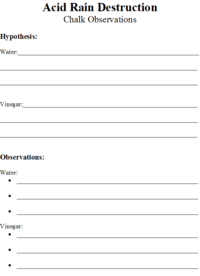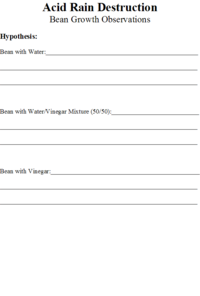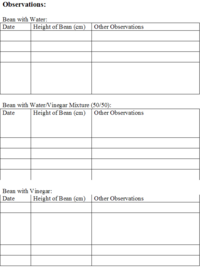Acid Rain Destruction
| Instant wiki maker | Making handouts | Editing tips |
Contents
- 1 Acid Rain Destruction
- 1.1 Student worthiness
- 1.2 Primary biological content area covered
- 1.3 Materials
- 1.4 Handouts
- 1.5 Description of activity
- 1.6 Lesson plan
- 1.7 Math connection
- 1.8 Literature connection
- 1.9 Connections to educational standards
- 1.10 Pitfalls
- 1.11 Good Idea
- 1.12 Demo Photos
- 1.13 Reflections
- 1.14 Next steps
- 1.15 Citations and links
Biology In Elementary Schools is a Saint Michael's College student project from a course that ran between 2007 and 2010 and fully described in this book chapter. The student-created resources have been preserved here for posterity. Link under 'toolbox' for printer-friendly versions of the exercises. Click on handouts to print full resolution versions. Please see Wikieducator's disclaimer, our safety statement, and the Creative Commons licensing in English and in legalese.
Acid Rain Destruction
Student worthiness
Tried and trusted.
Primary biological content area covered
Students will:
- understand the damaging effects of acid rain on the environment.
- understand the damaging effects of acid rain on plants.
- pose a hypothesis and use the scientific method.
Materials
Materials teacher will need:
- plastic table cloth
- paper towels
Materials each student will need:
- safety goggles
Materials each student group will need:
- three cups of vinegar
- three cups of water
- tablespoon
- white chalk
- eye droppers
- 2 foil pans
- small disposable paper cups
- permanent markers
- pestle and mortar (or other method to crush chalk)
- Resealable plastic storage bags
- rubberbands
- six medium plastic cups
- soil
- bean seeds or another type of plant seed
Handouts
Students will receive Figure 1 to record their hypotheses and observations of the chalk experiment.
Students will receive Figure 2 to record their hypotheses about the bean growth experiment.
Students will receive Figure 3 to record their data and observations of the bean growth experiment.
Description of activity
Students will explore the damaging effects of acid rain on the environment using the scientific method. The students will mimic the effects of acid rain in two different ways. In the first way, they will use water, vinegar, and chalk. The students will form a hypothesis about the effects of dropping water and vinegar separately on ground-up pieces of chalk. The students will record both their hypotheses and their observations. The second way in which students will explore the effects of acid rain is by growing beans. They will set up self-watering biodomes in large plastic bags in which the beans will grow. Each group will pot three beans, making three different biodomes. One bean will be watered with 2 tablespoons of water, one with 1 tablespoon of water and 1 tablespoon of vinegar, and one with 2 tablespoons of vinegar. Students will place these biodomes in a window and observe them each day, measuring and recording the height of each bean. Students will make hypotheses about the growth of the beans and then make a table to record their observations. Finally, the class as a whole can compile their results to make one master chart or graph.
Lesson plan
We will start with a brief conversation about what acid rain is and how it affects the environment. Students will be shown pictures of acid rain destruction of statues and forests (from the book in the literature connection). We will tell students that vinegar can represent acid rain, and will throughout both of the experiments. (5 minutes).
Students will work in groups, wearing safety goggles, and will grind up two pieces of white chalk using the pestle and mortar. They will then place the ground chalk into two different tin plates. They will make hypotheses (using Figure 1) about what will happen when vinegar is added to chalk and what will happen when water is added to chalk. Students will then use eye droppers to put one stream of water on the chalk in one of the tins and make observations (using Figure 1), and then they will put one stream of vinegar on the chalk in the other tin and make observations (using Figure 1). They will then be asked how this links to the damaging effects of acid rain in the environment (10 minutes).
Next, students will work as a group to plant beans in self-watering biodomes (each group will make a total of three biodomes). For each biodome, students will fill a medium-sized plastic cup with soil and will plant a bean in the center of the cup. Each plant will get 2 tablespoons of liquid: one will receive 2 tablespoons of water, one will receive one tablespoon of water and one tablespoon of vinegar, and one will receive two tablespoons of vinegar. Students will label the plastic cups based on the liquids that were placed in the soil. Students will place each cup in a storage-sized ziploc bag and make sure it is sealed tightly. Then they will place a rubber band loosely around the top of the cup, allowing the plant to grow through the opening and water itself. Students will place their bean plants in the window sill to allow them to grow and then observe. Students will form their hypotheses (using Figure 2) and then will collect data and make observations as the plants grow (using Figure 3) (10 minutes).
Students will spend any remaining time cleaning up the work area.
Math connection
After planting the beans in both water, vinegar, and the combination of the two, students will collect data of how tall the plants are and will record it in a chart (using Figure 3). Students can then use these data to create a graph of how tall each bean was from day to day or a graph that compares the ending heights of each of the beans grown in different liquids. They can then compile their results with the rest of their classmates' results and make a master graph. The results will show the students a concrete example of acid rain's affect on plant life.
Literature connection
- Morgan, Sally. 2005. Acid Rain. Hachette Children's Books.
- Although this book is not something that you would want to read straight through with students, there are certain passages that could be read aloud that would aid in their comprehension of what acid rain is. Also, showing students various photos in this book will help them understand the concept as well.
Connections to educational standards
Scientific Method: 7.1 Students use scientific methods to describe, investigate, explain phenomenon, and raise questions in order to: generate alternative explanations; design inquiry that allows these explanations to be tested; deduce the expected results; gather and analyze data to compare the actual results to the expected outcomes; and make and communicate conclusions, generating new questions raised by observations and readings.
Theories, Systems, and Forces: 7.15 Students demonstrate understanding of the earth and its environment, the solar system, and the universe in terms of the systems that characterize them, the forces that affect and shape them over time, and the theories that currently explain their evolution This is evident when: a. Identify and record evidence of change over time, e. Analyze and explain natural resource management.
Pitfalls
It is important to use chalk board chalk because we found that side walk chalk doesn't work. Also, make sure the chalk is white because the colored chalk did not show strong results, which is important because students need to see what "acid rain" does to the environment.
Also, it is important to help students place the rubber band over the plastic bag so that it is directly above the cup, allowing the plant to grow up through the space and creating a self-watering system.
Also, the soil for the beans should be well-moistened, but not muddy, to create a self-watering system. We suggest 2 tablespoons of liquid for a medium sized cup filled 2/3 with soil.
In order to accommodate the needs of ELL students, the handout can be changed to include a word bank of scientific terms that accurately describe the effects of water and vinegar on chalk. In addition, the handout can include a space for students to draw their observations if they have difficulties with handwriting.
Good Idea
Have the students wear safety goggles. They will really enjoy this!
Demo Photos
Reflections
I think that this lesson went extremely well and that the students got a lot out of it. Most of them were excited to wear the safety goggles and were enthused about how hands-on the activities were. Most of the students could not wait to drop the vinegar onto the chalk because they wanted to see it "explode". The majority of the students understood that the plants would not grow as well if they were watered with vinegar because they kept telling us that plants need sunlight and water to grow. However, some of the students were not making the connection between vinegar and acid rain even though we told them that acid rain acts like vinegar. I think that we could have helped them to understand this better if we had spent a little more time in the beginning of the lesson talking and reading about acid rain and then showing them more pictures of the destruction that it causes. I do think, however, that the two activities together made a strong impact on many of the students about the effects of acid rain on the environment.
Overall this activity went really well. The students were very excited to be hands on and were able to develop some good hypotheses on what they thought the vinegar would do to the chalk. I think it was a good idea to have the children crush up the chalk using the mortar and pestle because they really felt like it was their experiment. Mostly all of them enjoyed using the eye dropper and squirting the water and vinegar onto the chalk and watching the results. They were very excited if they happened to come up with the correct hypothesis. Most of them were able to relate the vinegar to acid rain and understand that what happened to the chalk could also happen to the environment. We were even able to pull in some info about pollution and how they can help preserve the environment if they don't pollute. I think the students also really liked creating the self watering plants and seemed to be excited to see if the bean watered with vinegar would grow at all. They were also really excited about wearing safety goggles!
The Acid Rain Destruction lesson went great. The students enjoyed it and left understanding the concept of acid rain. They were able to observe the chalk unaffected by the water and then its fizzing reaction to the vinegar imitating the affects of acid rain. The groups were successful at creating simple hypotheses and proving and disproving them. The activity was also set-up to be a continuous one because we planted beans seeds for the students to observe and measure overtime. A student from each group would water their plants with water, half vinegar half water, or just vinegar. The students will be able to compare their beans plants and better comprehend the affects of acid rain on the environment. Acid Rain Destruction used activities with both immediate and timely results that will leave a better impression on the kids. I would recommend this activity to other teachers for the second grade age group.
Our Acid Rain Destruction activity was quite successful with both classes. With each group we explained the cause and effects of acid on the environment before beginning the activity, and it appeared that the students were somewhat confused about the concept. However, after completing the chalk activity, the students seemed to have a clear understanding of the topic. We were able to evaluate their understanding through the hypotheses the students made about their self-watering plants. The students were quite excited to use the materials we provided them with because they felt like real scientists. The safety goggles and mortar/pestle were a big hit with the students. We did have a difficult time getting the students to write down their hypotheses before experimenting with the materials because they were excited for the hands-on part. Whether they wrote down their predictions, the students came up with great ideas about what would happen with the chalk and vinegar. In addition, I think the concept of acid rain will be even clearer when the students observe the growth of their plants. The students will be able to track the growth of their plants and compare/contrast their results. The teachers seemed excited about the use of plastic bags so that the plants are self-watering. This allows the student to focus on the growth patterns without having to care for the plants. Overall, I really enjoyed teaching this activity, and I think it is a great lesson to teach because it can be connected to many other topics with biology.
Next steps
The self-watering biodomes could also be used to explore the water cycle. A connection could easily be made to this lesson plan: Water Around and Around Again.
A connection could also be made to plant needs, discussing what plants need in the environment in order to survive and grow the best.
Also, someone could extend on this lesson by talking about pollution and how important it is to recycle so we don't create acid rain and cause any more damage then has already been caused.
Citations and links
This idea was adapted from: http://www.col-ed.org/cur/sci/sci208.txt
The following images are from: Wikimedia Commons







